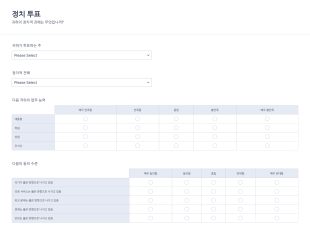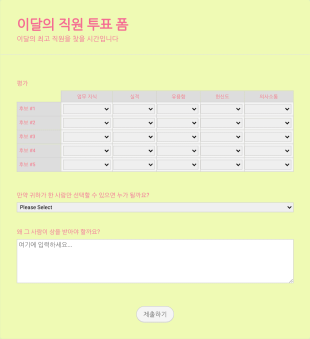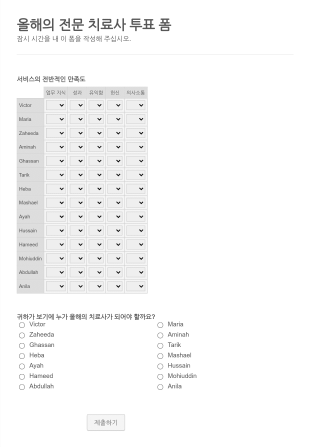투표 양식
투표 양식 정보
투표 양식은 참가자 그룹으로부터 투표나 선호도를 수집, 정리, 분석하기 위해 설계된 디지털 도구입니다. 이는 선거, 여론조사, 설문조사, 시상식 추천, 이벤트 기획, 조직·학교·커뮤니티 내 의사 결정 과정 등에 널리 사용됩니다. 투표 양식은 새로운 팀 리더를 선출하거나 인기 프로젝트를 선택하거나 효율적인 집단 결정을 내리는 등의 의견 수렴 과정을 간소화합니다. 공식 선거뿐만 아니라 비공식적인 여론 조사에도 적합하며, 모든 참가자의 의견이 정확하게 반영되도록 돕습니다.
Jform을 사용하면 누구나 직관적인 드래그 앤 드롭 양식 빌더와 다양한 템플릿을 활용해 상황에 맞는 투표 양식을 손쉽게 만들고 사용자 지정할 수 있습니다. 코딩이 필요 없는 플랫폼으로, 몇 분 만에 전문적인 투표 양식을 디자인하고, 조건부 논리를 추가해 투표 경험을 맞춤화하며, 다른 도구와 통합해 데이터 관리도 원활히 할 수 있습니다. 제출된 응답은 자동으로 저장되고 정리되어 결과 검토와 공유가 간편합니다. 빠른 설문이든 대규모 선거든, Jform의 투표 양식은 안전하고 효율적으로 투표를 수집하고 관리할 수 있도록 도와줍니다.
Use Cases of Voting Forms
투표 양식은 다양한 상황에 맞게 조정할 수 있으며, 각기 다른 요구와 장점을 지닙니다. 누가 어떻게 사용할 수 있고, 구조가 어떻게 달라질 수 있는지 살펴보세요.
1. 사용 가능 사례:
- 학생회나 반대표 선거 등 학교 투표
- 이달의 직원 또는 사내 시상 투표
- 커뮤니티 또는 클럽의 의사결정 (예: 이벤트 주제 선정 등)
- 청중 선호도나 피드백을 위한 온라인 설문
- 조직 내 위원회 또는 이사회 선거
- 시상식 후보 추천 및 수상자 선정
2. 문제 해결 포인트:
- 투표 과정을 간소화하고 수작업 집계 오류를 줄임
- 투표의 익명성과 공정성 보장
- 원격 참여를 지원하여 모든 이해관계자가 쉽게 접근 가능
- 빠른 의사결정을 위한 즉각적인 결과와 분석 제공
3. 예상 사용자 및 소유자:
- 학교 관리자, 교사, 학생 대표
- 기업의 HR 매니저 및 팀 리더
- 클럽 회장 및 행사 주최자
- 청중 설문을 진행하는 마케팅 팀
- 청중 설문을 진행하는 마케팅 팀
4. 제작 방식 차이점:
- 학교 선거: 익명 투표 옵션과 함께 학번, 학년, 후보자 선택 필드가 필요할 수 있습니다.
- 직원 시상식: 후보자 이름, 부서, 추천 이유 등을 포함할 수 있습니다.
- 커뮤니티 설문: 객관식 질문이나 순위 선호도 중심일 수 있습니다.
- 공식 선거: 보안 인증, 고유 유권자 코드, 결과 검증 필드가 필요할 수 있습니다.
요약하자면, 투표 양식은 매우 유연하며, 각 사용 사례의 상황과 요구사항에 따라 콘텐츠와 구조를 조정해야 합니다.
투표 양식 만드는 방법
Jform으로 투표 양식을 만드는 과정은 간단하며, 빠른 설문부터 공식 선거까지 어떤 상황에도 맞게 커스터마이징할 수 있습니다. 아래는 효과적인 투표 양식을 설계, 실행, 관리하는 단계별 가이드입니다.
1. 적합한 템플릿 또는 빈 양식으로 시작하기:
- Jform 계정에 로그인한 뒤, 내 작업공간 페이지에서 “생성”을 클릭하세요.
- “양식”을 선택하고 새로 시작하거나, Jform의 방대한 라이브러리에서 투표 양식 템플릿을 선택하세요.
- 학교 선거, 직원 시상, 지역 여론조사 등 다양한 상황에 맞는 템플릿이 제공되어 설정 시간을 절약할 수 있습니다.
2. 적절한 레이아웃 선택:
- 빠른 투표에는 클래식 양식(모든 질문 한 페이지), 집중된 경험에는 카드 양식(한 번에 한 질문)을 선택하세요.
- 공식 선거의 경우, 카드 양식을 사용하면 유권자가 한 번에 한 후보 또는 한 질문에 집중할 수 있습니다.
3. 양식 요소 추가 및 커스터마이징:
- 드래그 앤 드롭 양식 빌더를 사용해 필수 필드를 추가하세요:
- 유권자 신원 확인 (익명 투표일 경우 선택 사항)
- 후보자 또는 선택 항목 (라디오 버튼, 체크박스, 드롭다운)
- 추가 의견 또는 선택 이유 (단답형/서술형 텍스트 필드)
- 보안 기능 (고유 코드, CAPTCHA, 이메일 인증 등)
- 시상식 투표의 경우, 후보자 정보와 추천 사유를 입력할 수 있는 항목을 포함하세요.
4. 디자인 맞춤화:
- 페인트 롤러 아이콘을 클릭하여 양식 디자이너를 여세요.
- 조직 또는 이벤트 브랜딩에 맞게 색상, 글꼴, 테마를 조정하세요.
- 로고를 추가하고 양식 URL을 맞춤화해 전문성을 높이세요.
5. 조건부 로직 및 알림 설정:
- 조건부 논리를 사용해 이전 답변에 따라 항목을 표시하거나 숨길 수 있습니다. (예: “기타”를 선택한 경우에만 의견란 표시)
- 새 제출 알림을 받을 수 있도록 이메일 알림을 설정하고, 필요한 경우 유권자에게 확인 메일을 전송하세요.
6. 양식 게시 및 공유:
- “게시”를 클릭하고 양식 링크를 복사해 이메일, 소셜 미디어 또는 웹사이트에 삽입하세요.
- 보안을 위해 로그인 필수 설정이나 고유 초대 링크를 사용해 접근을 제한하세요.
7. 테스트 및 제출 모니터링:
- 양식을 미리 보고 테스트 투표를 제출해 모든 기능이 의도한 대로 작동하는지 확인하세요.
- Jform 테이블에서 제출 현황을 실시간으로 모니터링하고, 고급 검색과 필터링 기능으로 결과를 분석하세요.
8. 결과 검토 및 발표:
- 투표가 완료되면 데이터를 내보내거나 Jform의 내장 분석 기능을 사용해 결과를 집계하세요.
- 필요에 따라 참가자에게 결과를 공유해 투명성과 신뢰를 유지하세요.
이 단계를 따르면, 데이터 무결성을 보장하고 모든 참가자에게 원활한 경험을 제공하는 맞춤형 투표 양식을 만들 수 있습니다.
자주하는 질문들
1. 투표 양식이란 무엇인가요?
투표 양식은 의사결정, 선거 또는 설문조사를 위해 참가자들의 투표, 선호도 또는 의견을 수집하는 온라인 도구입니다.
2. 온라인 투표 양식은 왜 중요한가요?
온라인 투표 양식은 투표 과정을 간소화하고 수작업 오류를 줄이며, 원격 참여를 가능하게 하고 즉각적인 결과를 제공하므로 현대 조직과 커뮤니티에 이상적입니다.
3. 투표 양식에서는 일반적으로 어떤 정보를 수집하나요?
투표 양식에는 유권자 신원(익명 투표가 아닐 경우), 선택한 옵션이나 후보자, 추가 의견, 그리고 보안 인증 정보가 포함될 수 있습니다.
4. 투표 양식에는 어떤 종류가 있나요?
예, 투표 양식은 학교 선거, 직원 시상, 지역사회 여론조사, 이사회 선거 등 각기 다른 용도에 맞게 맞춤 설정할 수 있으며, 각각 고유한 항목과 요건이 있습니다.
5. 누가 투표 양식을 사용할 수 있나요?
투표 양식은 학교, 기업, 동아리, 비영리 단체, 행사 주최자 등 집단 의사결정이나 의견 수집이 필요한 모든 단체에서 사용됩니다.
6. 온라인 투표 양식에서는 유권자의 개인 정보가 어떻게 보호되나요?
양식을 익명으로 설정하거나 접근을 제한하고, 안전한 데이터 저장 및 암호화 기능을 사용하면 유권자 개인정보를 보호할 수 있습니다.
7. 투표 양식은 동일한 사람이 여러 번 제출하는 것을 방지할 수 있나요?
예, 투표 양식은 이메일, IP 주소 또는 고유 코드로 응답을 제한하도록 설정할 수 있어, 한 사람이 한 번만 투표하도록 보장할 수 있습니다.
8. 디지털 투표 양식을 사용하는 주요 이점은 무엇인가요?
디지털 투표 양식은 시간을 절약하고, 비용을 줄이며, 오류를 최소화하고, 원격 참여를 가능하게 하며, 즉각적이고 체계적인 결과를 제공해 분석을 쉽게 합니다.




